There’s always a certain charm about yo-yo clubs. Well, for a neutral like me, at least. As a fan, it may not be as charming to see a significant portion of your club’s Wikipedia page titled ‘Chronic instability (since 1980)’, as is the case for RC Strasbourg.
Strasbourg very much fit the description of a yo-yo club. The end of the 1970s was their golden age: Strasbourg gained promotion to the top flight, finished in the top three, qualified for European competition, and won their first (and, in the end, only) league title in 1979. But the next couple of decades saw them constantly bouncing up and down between the first two divisions, somehow winning two cups in the meantime, before going bankrupt in 2011 and having to work their way up from the fifth tier to being a bottom-half Ligue 1 side over the course of the 2010s. Strasbourg finished the 2020-21 season in 15th place, which seems about right considering their resources relative to the rest of the league.
In May 2021, things were to change. Strasbourg announced the appointment of Julien Stéphan as their new manager. This surprised many onlookers because it looked like he could have aimed higher than a bottom-half side at that point.
Stéphan had just come off the back of a spell at his local club Stade Rennais: an impressive showing, even if it didn’t end very well. After three years managing Rennes’s B side, his big break came in 2018, when Sabri Lamouchi’s sacking led to Stéphan’s appointment as interim manager. Then, a series of good results helped him become their permanent manager. In the second half of the 2018-19 season, Rennes reached the Europa League’s round of 16 and won the Coupe de France, the club’s first major trophy in 48 years. With a crop of talented players, like Eduardo Camavinga and Raphinha, Rennes continued to climb the ladder under Stéphan, finishing third in 2019-20 and qualifying for the Champions League.
But in March 2021, after Rennes suffered four straight defeats, Stéphan resigned.
A year after Stéphan’s appointment, Strasbourg are in a very different place. They currently sit in sixth place, just two points outside the European places. This is unprecedented in the modern age for Strasbourg, considering their resources. Their rise is almost certainly down to the manager and his tactical setup.
With that in mind, let’s dive deeper into how Strasbourg play under Stéphan and analyse how the Frenchman has turned the club’s fortunes around.
General Flexibility
One defining aspect of Strasbourg this season under Stéphan is their tendency to play differently in different contexts.
Firstly, their tactics seem to vary based on whether they’re playing at home or away. As we can see in the below plot, Strasbourg tend to attack more directly and press less intensely (and defend more deeply) in away fixtures. On the other hand, they press higher and keep possession more at home.
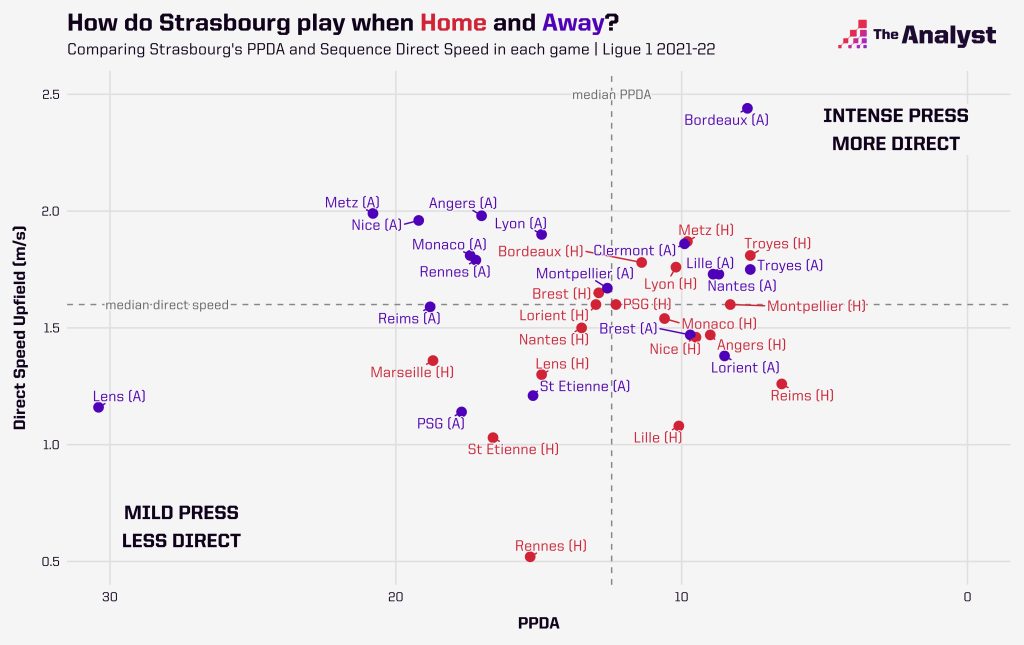
On top of this, they seem to vary their tactics to match up against the opposition.
While Strasbourg largely allow their opponents to play their usual style (as indicated by the strong correlation between Strasbourg’s opponents’ possession against Strasbourg and their possession when playing other teams), they make life harder for the opposition by adjusting their own tactical set up.
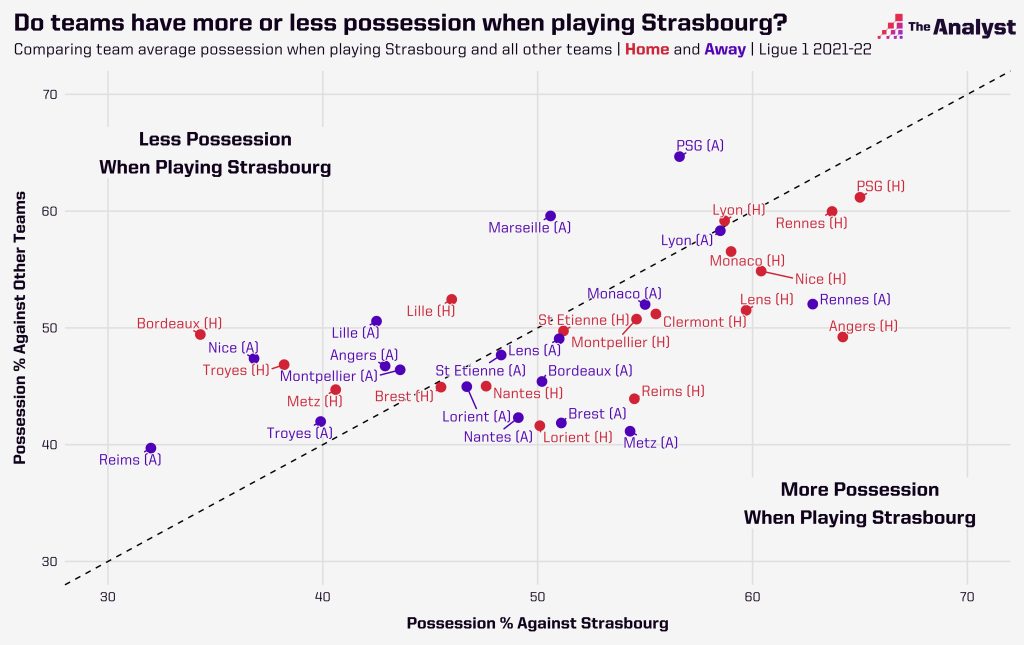
That said, across different games and against different opponents, there are many characteristics of Strasbourg’s game under Stéphan that do seem to stay constant, and they’re worth exploring.
The Attack
In general, Strasbourg are pretty good going forward. They have 53.8 non-penalty expected goals, the fourth-highest mark in the league. What do they do in attack?
1. Fairly Direct Going Forward
Strasbourg are largely a direct, fast-moving side. Their attacking speed upfield is 1.6 metres per second, the eighth-fastest in the league. They average 34.9 passes per shot, the third-lowest in the league, indicating they don’t pass it around much to move the ball up the pitch.
They also attempt 59.1 long passes per game, the third-highest figure in the league. The team style comparison below places them in the ‘fast and direct’ quadrant.
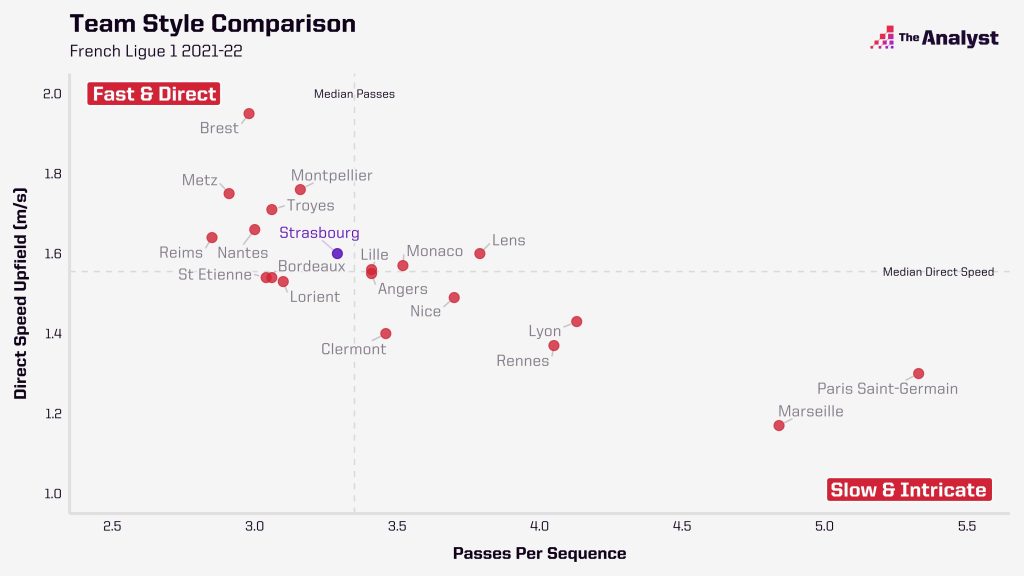
But the most interesting part of Strasbourg’s attacking game is what enables them to move this quickly up the pitch from non-counterattacking situations.
2. Great Off-Ball Movement in Possession
Many good attacking sides these days, like Erik ten Hag’s Ajax and Gian Piero Gasperini’s Atalanta, seem to be defined by their movement off-the-ball in possession. Stéphan’s Strasbourg are yet another example. The most striking feature of Strasbourg’s attacking play is what the players do without the ball, with lots of positional rotations, interchanges, and third-man runs enabling progression into space.
When Strasbourg have the ball in the opposition’s half in their 3-5-2, the wing-backs start high and wide, almost in line with the two strikers, while one of the number 8s, usually Adrien Thomasson, joins this near-front-four in making runs in behind. When a player (or two) drops back, drawing out a defender, another player makes a well-synchronised attacking run into the space that the other player vacates. Here’s one example from their 3-3 draw with PSG, with Ludovic Ajorque coming deep while Kevin Gameiro and Thomasson exploit the space in behind.
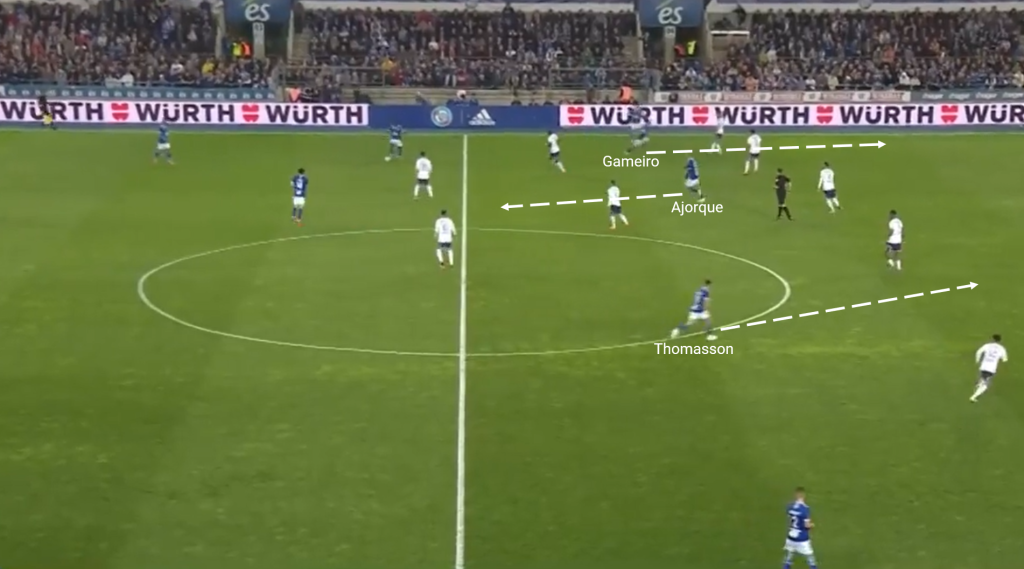
Strasbourg’s options at striker also help. They generally use a classic big man/small man pairing up top, with the pair complementing each other. Stéphan usually picks two out of the strong 6’6” target man Ajorque, the agile 5’8” Gameiro on his Strasbourg return, and 6’1” Habib Diallo, who’s somewhere between those two skillset-wise.
When one striker drops deeper between the lines, usually taking an opposition centre-back with him, the other plays on the shoulder of the defender and attacks space in behind. Here’s an example from their last game against Brest, with Diallo dropping back into space between the lines and receiving a long pass from Maxime Le Marchand, while Gameiro makes a run into the channel that Diallo vacates.
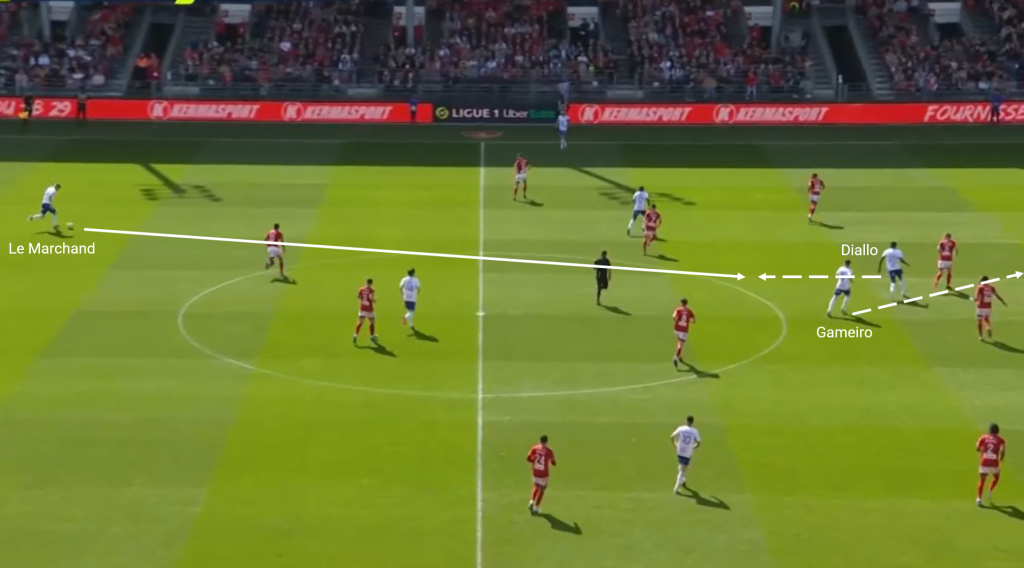
Ajorque’s goal against Nice in December 2021 (at 0:38 in this video) is a good example of Strasbourg’s movement enabling a direct sequence that results in a goal.
Strasbourg attempt the fewest dribbles in the league, no doubt related to their emphasis on off-ball movement. The lack of focus on dribbling indicates Strasbourg break defensive lines and get past opponents by positioning players between the lines and delivering passes to them, rather than by dribbling past players. Stéphan’s side play the most passes per minute of possession in the league (23.2), showing they don’t hold onto the ball for very long between passes.
4. Making Good Use of the Wings via Overloads and Switches, Before Creating Chances With Crosses
In Strasbourg’s 3-5-2, the wing-backs, generally Dimitri Liénard on the left and Frédéric Guilbert on the right, start high and wide, usually with the wing-back on the far side of the ball starting higher. These wing-backs play a prominent role in Strasbourg’s attack.
As Strasbourg move up the pitch, they often overload one side, attracting opposition defenders to that side too, before playing a cross-field switch into space for the wing-back on the other flank. It’s generally the left-wing that is overloaded while the ball is played to the right flank more often, which seems to fit the pattern of profiles Strasbourg play with – Liénard and Bellegarde on the left seem to be better passers, while Guilbert and Thomasson seem to attack space better.
Here’s an example of a switch to the right flank, from Djiku to Guilbert, following a passing move on the left.
Thomasson, like he often does, makes a good spontaneous run into space, and heads Guilbert’s cross into the net.
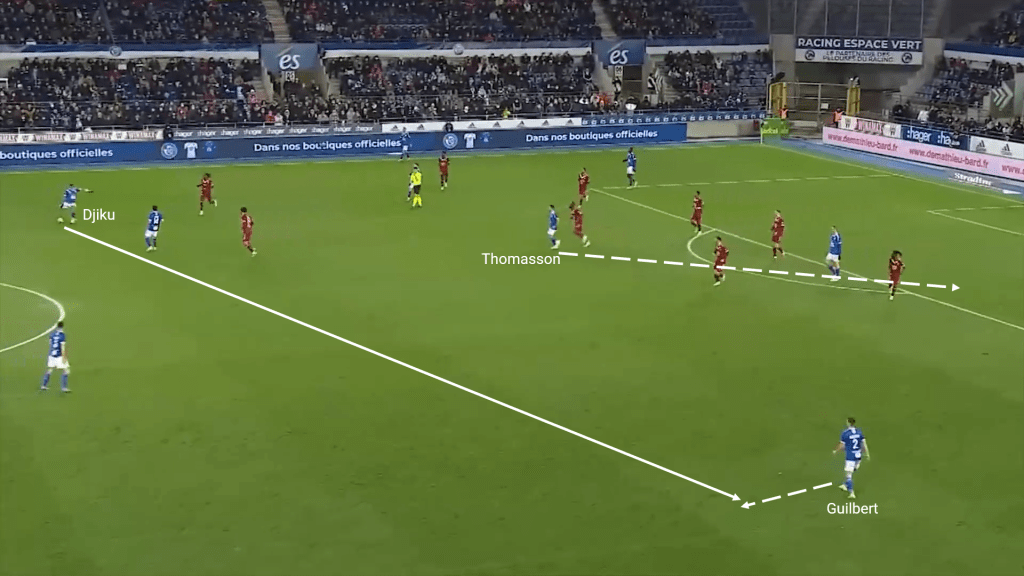
This brings us to another point. A natural result of their use of the wings, Strasbourg create a ton of chances from crosses. They attempt the most crosses in the league with 21.6 per game, and 31.1% of their shots are directly assisted by crosses, the highest percentage in the league. No team has created more chances or scored more goals from crosses than Strasbourg.
Like the earlier example of Guilbert’s cross, many of Strasbourg’s chance-creating crosses are inswingers from deeper areas, as this visualisation shows.
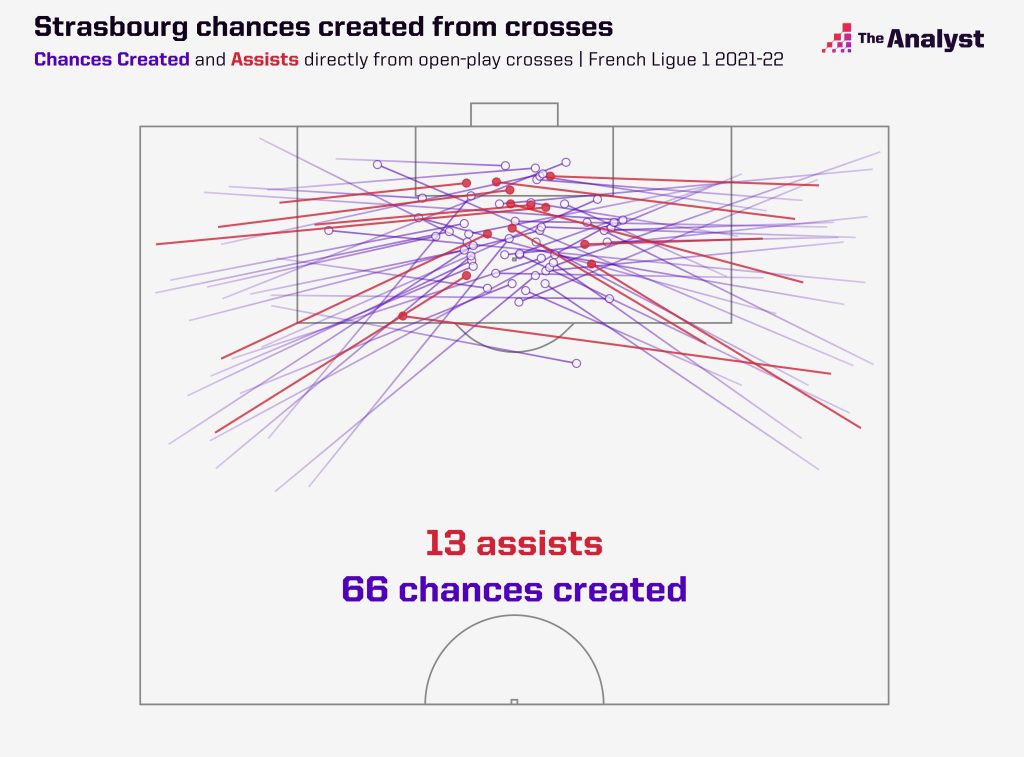
Their strikers’ aerial ability and skill in finding space inside the box with their movement, enables Strasbourg to carve out good chances. In fact, Ajorque has scored more headed goals this season in Ligue 1 than any other player, while Thomasson is joint-third on three. Headers account for 22% of all Strasbourg’s league goals at the moment, a sum that no team can better.
Moreover, the fact that Strasbourg commit lots of bodies in the box for crosses, especially for inswingers from deeper positions, helps them create good shots, with the added personnel helping via flick-ons, decoy runs, screens, and recoveries from inaccurate crosses. An example is Thomasson’s goal against Montpellier, at 2:35 here.
While only the crosser and the goalscorer may get the credit for a goal from a cross, for Strasbourg, their success from crosses is very much a team effort.
6. Good Shooting Locations
Strasbourg tend to create good shots at the end of their possession sequences. Their xG per shot in open play is 0.13, the fourth-highest in the league. They also take just 32% of their shots from outside the box, the second-lowest figure in the league. As we can see in the shot map below, they’ve taken a large number of shots in the central areas of the box. And as expected goals savants will know, shots from close and central locations are a very good way to score goals.
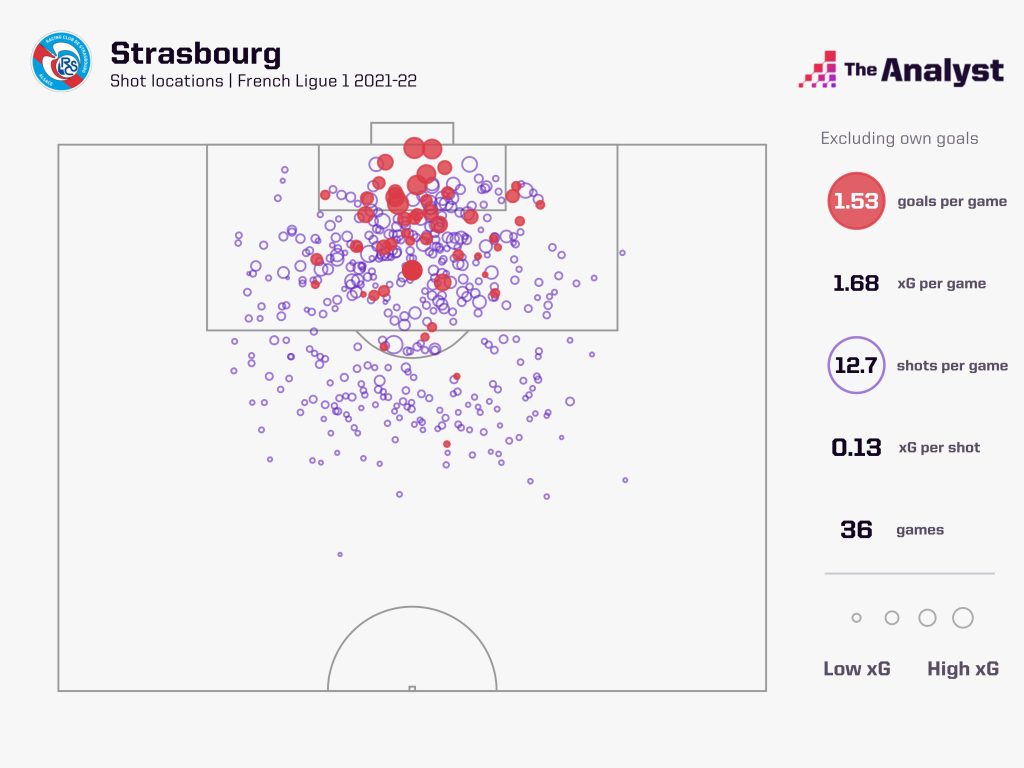
This is yet another indicator of how good their possession play is, and their ability to put players into space close to the opposition’s goal.
7. Set-Piece Threat
While Stéphan’s Strasbourg are a very good attacking side in open play, set pieces are also a prominent weapon in their arsenal. So far this season they’ve create the second-highest xG from set pieces in the league, with 13.6.
For corners, Guilbert and Liénard generally deliver outswingers. Against man-marking and hybrid defences (where teams defend with some man-markers and some zonal-markers), one or two players (usually Ajorque and/or another tall player) man the near post, often being targets for flick-ons, while three-to-four players move around in the middle of the penalty area. Here’s an example of what that looks like.
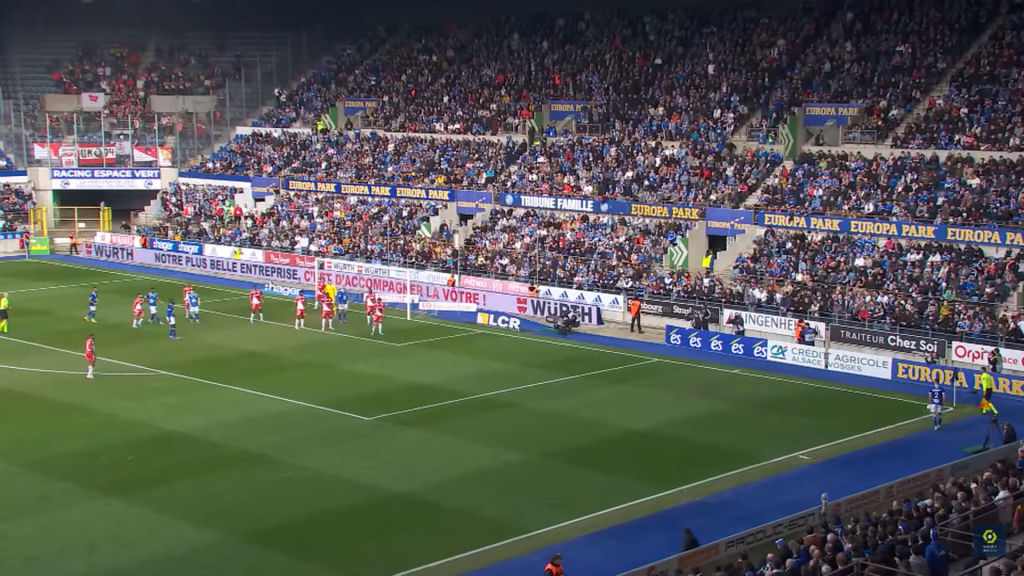
Against pure zonal defences, four-to-six players simply crowd the penalty area, as you can see here.
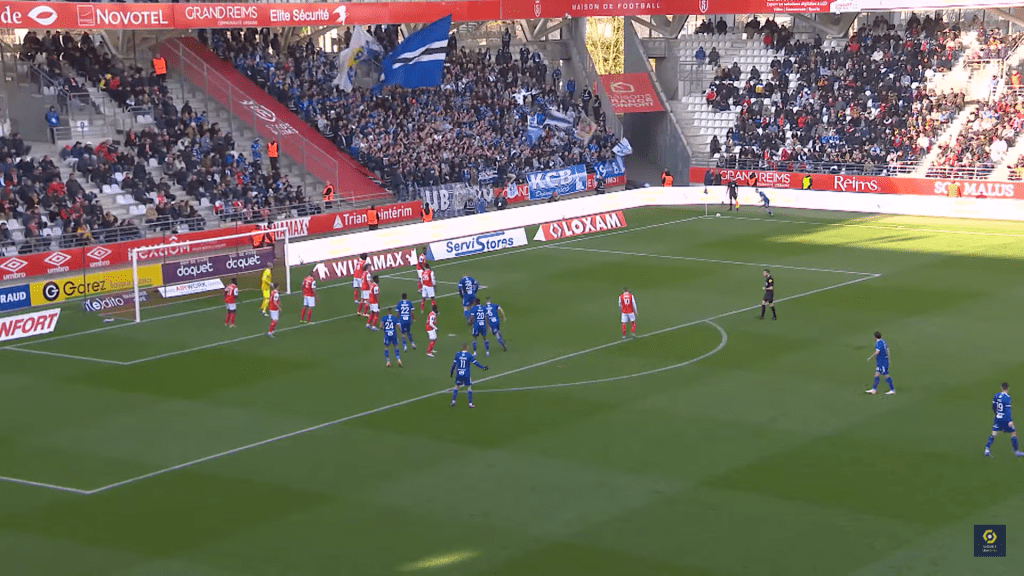
Strasbourg’s players tend to move around well inside the box when the delivery comes in. Their collective aerial ability helps, too. They also score goals from flick-ons, rebounds, and instant recoveries from set pieces.
An example of where a disruptive run can create a chance from a free-kick is Lucas Perrin’s run here for his goal (at 1:35 in this video) against ASSE.
All in all, Strasbourg are a complete attacking side that is punching above their weight, and Stéphan’s tactical setup has had a massive part to play in this.
The Defence
Strasbourg’s defence may not be as good as their attack, but it is still healthy, conceding the sixth-fewest goals in the league with 39. Let’s take a look at what they do without the ball.
1. A Moderately High Press, but One That Constantly Wins the Ball in Advanced Areas
In Ligue 1, Strasbourg have the seventh-lowest PPDA (passes per defensive action in the middle and attacking third; a lower PPDA indicates a more intense high press) with 12.3, and make the most ‘high turnovers’ (possession wins within 40 metres of the opposition’s goal) with 9.6 per game. 1.5 of these high turnovers per game also lead to shots, highlighting how their pressing is an attacking weapon, too.
While they don’t seem to attempt to press the opposition centre-backs or goalkeeper, with the strikers cutting off passing options rather than looking to win the ball aggressively, they do seem to press the next stage of the opposition’s build-up, especially out wide. More on that next.
2. Forcing the Opposition’s Build-up Wide, Where They Apply More Pressure to Win the Ball
You’ve probably heard the (possibly apocryphal) Pep Guardiola quote about the touchline being the best defender quite a few times. Strasbourg seem to follow this idea when trying to win the ball back from the opposition high up the pitch and in the middle third, restricting central passing options with their three-man midfield and striker pairing, forcing the opposition out wide. Here’s an example of their narrow defensive shape in midfield and how they leave wider options open.
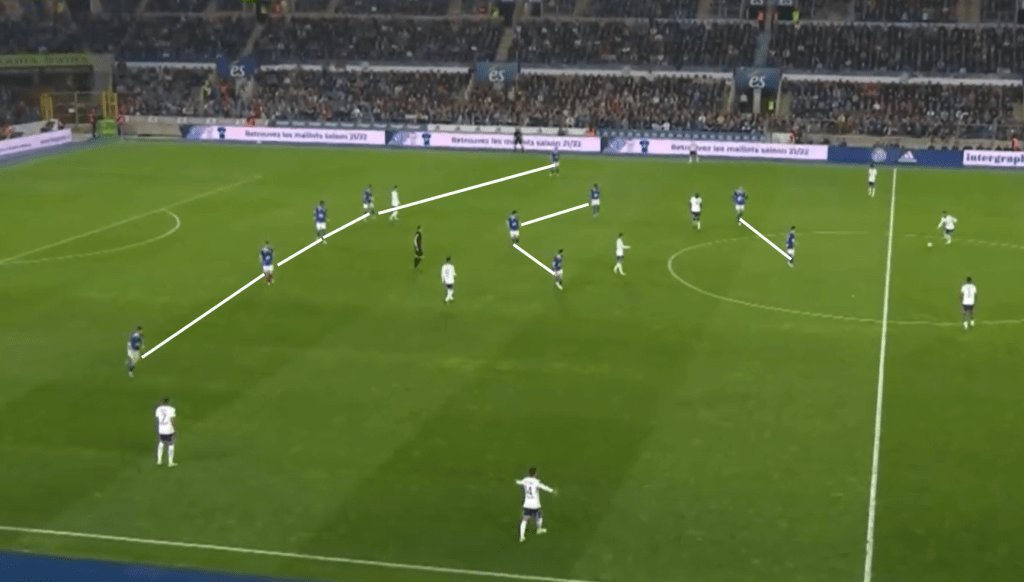
When their opponents move the ball out wide, they seem to push up and apply more intense pressure, when the opposition has one side of the pitch cut off as a passing option. Here’s an example (Strasbourg are the team in white here).
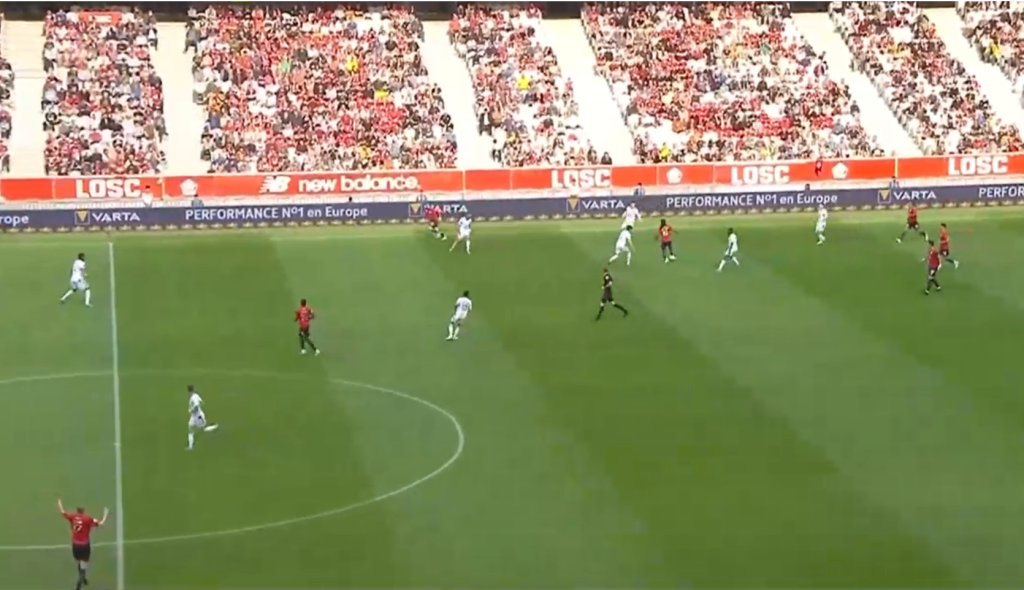
We can see evidence of this in the data. As you can see in this map of where Strasbourg win the ball back in the attacking third, there are large clusters on the flanks, where the wing-backs and central midfielders step up and surround the player with the ball and win possession.
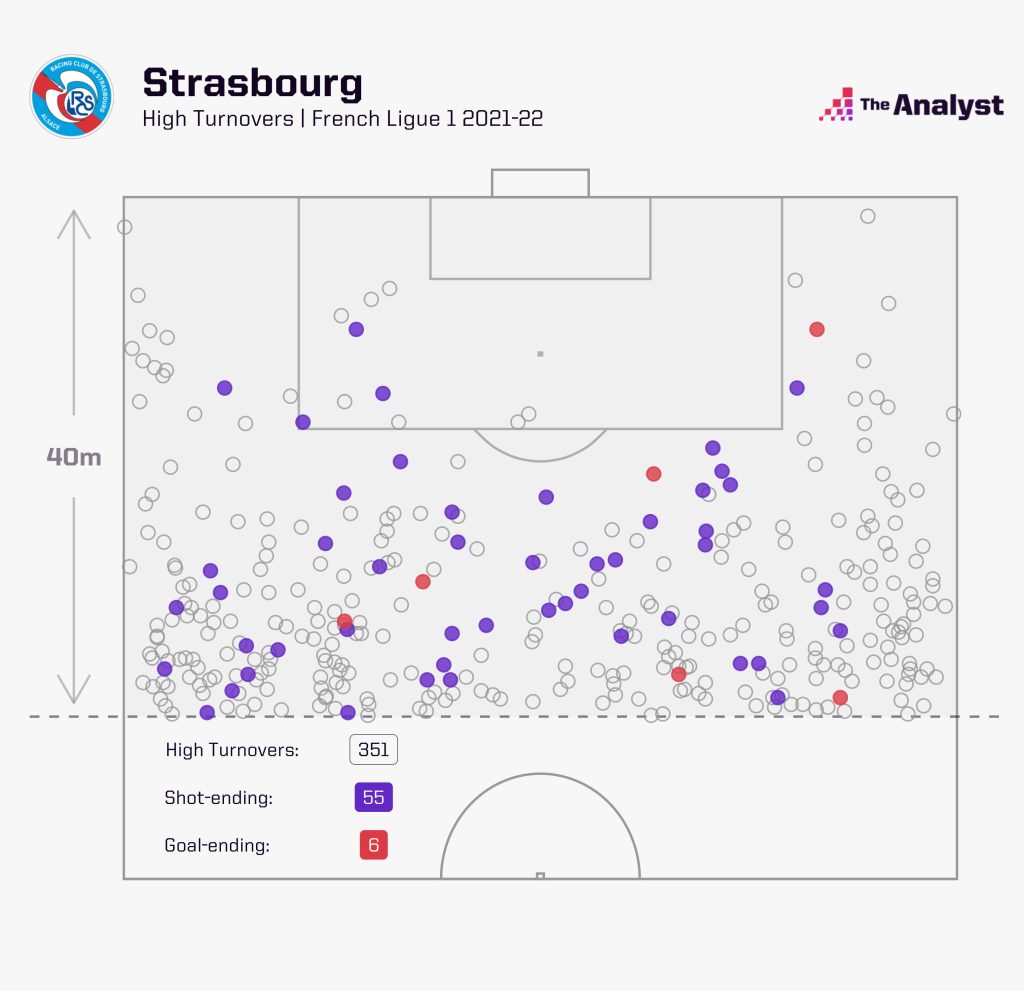
As a result of this narrow defensive starting position, opponents tend to play longer passes against them to play around the block. Opponents attempt 60 long passes against Strasbourg per game, which is the highest in the league.
Plus, because Strasbourg restrict central passing options well, with their largely player-oriented press, opponents have to pass it around a lot before being able to create chances, indicated by Strasbourg conceding the most passes per shot in the league with 45.6.
3. Good Protection Close to Their Own Goal
An upshot of Strasbourg’s defensive shape is that they don’t let the opposition into central areas close to their goal. As we can see in this chart, Strasbourg concede the fifth-fewest entries into the box.
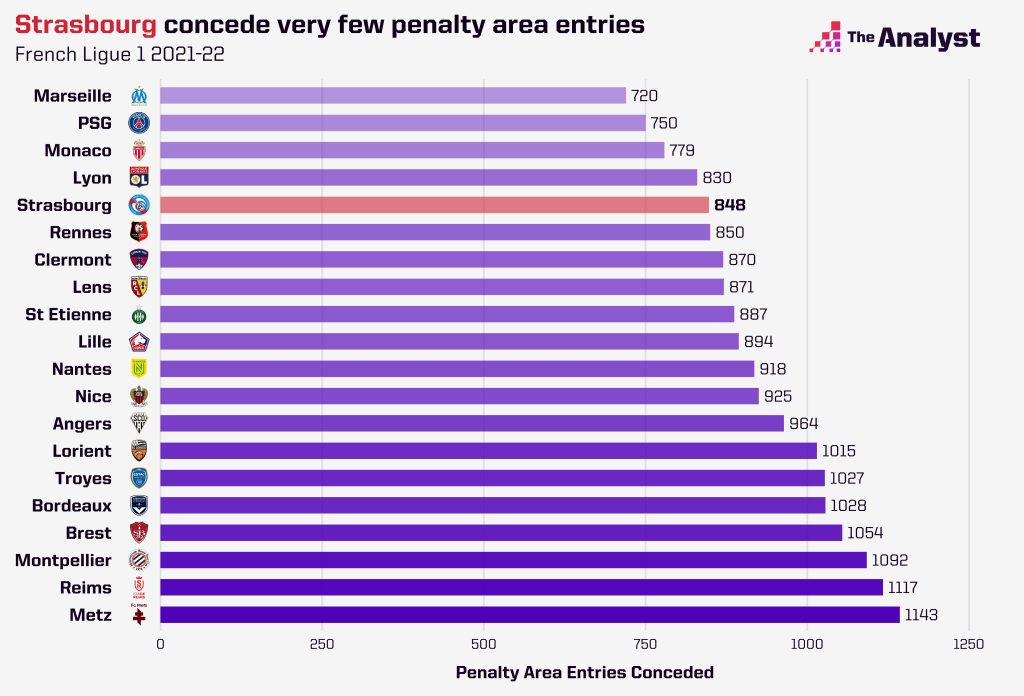
While Strasbourg’s attack is the more notable part of their game, they’re a good defensive side, too.
All in all, there is a lot to suggest that Julien Stéphan is a promising young coach. There is no doubt that Strasbourg are overachieving relative to their resources and doing much better than they were before appointing the Frenchman. As capable as the squad is, Strasbourg look like a side that is less about the individual players and more about their positionally-intricate tactical system under Stéphan.
But for me, the standout feature of what we’ve seen of Stéphan as a manager is his flexibility and ability to adapt to the situation. It goes beyond the game-to-game basis, too. His Rennes last season were a very different side; a more archetypal slow-moving, high-possession team that didn’t have the same emphasis on off-ball movement, taking on players a lot more – likely to be a function of the skillsets that Stéphan had available at Rennes. On the other hand, at Strasbourg, he seems to have built a functional system around the players available to him, maximising their strengths. Many of Strasbourg’s players seem to be doing much better than expected this season under Stéphan, and it may indicate that he can get the best out of different kinds of players.
It’s an exciting time for Strasbourg right now. They’re decently positioned to qualify for Europa and achieve their highest top-flight finishing position in more than 40 years. It’s an exciting time for Stéphan’s career, too. Bigger clubs are rumoured to be circling, and from what we’ve seen of him so far, there seems little doubt that he’ll be able to make the leap.
Until he does make the move, let’s sit back and watch just how far Strasbourg can go.
Enjoy this? Subscribe to our mailing list to receive exclusive weekly content.
Design by Matt Sisneros
